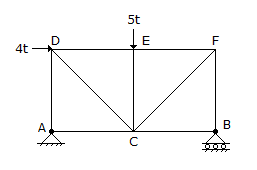Civil Engineering :: Theory of Structures
-
Stress may be expressed in Newtons
-
Principal planes are subjected to
-
Keeping the depth d constant, the width of a cantilever of length l of uniform strength loaded with a uniformly distributed load w varies from zero at the free end and
-
The total strain energy of a beam of length L, having moment of inertia of its section I, when subjected to a bending moment M, is
-
A load of 1960 N is raised at the end of a steel wire. The minimum diameter of the wire so that stress in the wire does not exceed 100 N/mm2 is :
-
The force in BF of the truss shown in given figure, is

-
The radius of gyration of a section of area A and least moment of inertia I about the centroidal axis, is
-
A simply supported beam carries varying load from zero at one end and w at the other end. If the length of the beam is a, the maximum bending moment will be
-
A simply supported beam carries varying load from zero at one end and w at the other end. If the length of the beam is a, the maximum bending moment will be


 Whatsapp
Whatsapp
 Facebook
Facebook




